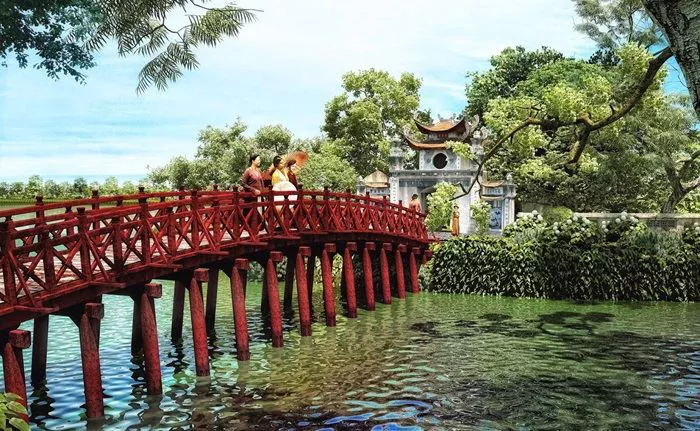Ngoc Son Temple is a famous historic and cultural site located on Hoan Kiem Lake in Hanoi, Vietnam. It attracts many visitors because of its beautiful scenery, deep history, and spiritual meaning. This temple is not only a place of worship but also a symbol of Vietnamese culture and religion, especially related to Buddhism.
Historical Evolution of Ngoc Son Temple
Early Origins and Establishment
Ngoc Son Temple was built in the 18th century. It was originally dedicated to several important figures in Vietnamese history and religion, including the national hero Tran Hung Dao, the scholar Van Xuong, and the Taoist deity Tran Vu. Over time, the temple became a place where people worshipped various spiritual figures, blending Buddhism, Taoism, and Confucianism.
Development Through Dynasties
During the Nguyen Dynasty, Ngoc Son Temple was renovated and expanded. The temple became more important as a cultural and religious center in Hanoi. It was a place where locals came for prayer, cultural activities, and festivals. The temple’s connection with Buddhist temples in the area helped spread Buddhist values among the people.
Modern Times and Preservation
In recent years, Ngoc Son Temple has been carefully preserved as a historic site. Many restoration projects have helped maintain its traditional features. Today, it is a popular tourist destination and a symbol of Hanoi’s rich cultural heritage. The temple continues to host religious ceremonies and attracts Buddhists and visitors alike.
Architectural Art of Ngoc Son Temple
Overview of Temple Architecture
The architecture of Ngoc Son Temple is a fine example of traditional Vietnamese design combined with Buddhist influence. It reflects the harmony between human creativity and nature. The temple is built on a small island, connected to the shore by a red wooden bridge called The Huc Bridge, which means “Morning Sunlight.”
Main Structures of the Temple
The temple complex includes several important buildings:
- The Main Hall: The heart of the temple where the altars and statues are kept.
- The Pavilion of the Precious Sword: This pavilion houses the sword of the legendary turtle, a symbol of protection and power in Vietnamese culture.
- The Temple of Van Xuong: Dedicated to the scholar, showing the respect for knowledge and learning.
Each building uses traditional wooden structures with curved roofs and intricate carvings. The roofs are decorated with dragons, phoenixes, and lotus flowers, which are important symbols in temple architecture.
Artistic Details and Symbolism
The temple’s art features many symbolic motifs from Buddhist teachings. The lotus flower, representing purity and enlightenment, appears throughout the temple’s decoration. Dragons symbolize strength and protection. The use of red and gold colors reflects happiness, prosperity, and spiritual power. These artistic choices connect the temple to Buddhist philosophy and Vietnamese culture.
Cultural Significance of Ngoc Son Temple
Religious Importance
Ngoc Son Temple plays an important role in the spiritual life of Hanoi’s people. It is a place for prayer and meditation, where Buddhists come to seek peace and blessings. The temple also honors important historical figures who represent wisdom, courage, and virtue, which are values highly regarded in Buddhism and Vietnamese traditions.
Role in Festivals and Community
The temple is the center of several traditional festivals, especially during Lunar New Year and the Mid-Autumn Festival. During these times, locals gather to pray for good fortune and to celebrate cultural heritage. These events strengthen community bonds and keep traditional beliefs alive.
Tourism and Education
Ngoc Son Temple attracts thousands of visitors every year, both Vietnamese and foreigners. It serves as a cultural education site where people learn about Buddhism, Vietnamese history, and temple architecture. Through tourism, the temple also helps support local economies and promotes cultural exchange.
Ngoc Son Temple in the Context of Buddhist Architecture
Relation to Other Buddhist Temples
Though Ngoc Son Temple integrates elements from different religions, its architectural style shares many features with Buddhist temples in Vietnam and across Asia. The use of symbolic decoration, natural materials, and peaceful settings is typical of Buddhist temple design. It reflects the Buddhist ideal of harmony between humans and nature.
Importance of Buddhist Architectural Principles
Buddhist architecture often emphasizes simplicity, balance, and spiritual symbolism. Ngoc Son Temple follows these principles through its layout and artistic details. The careful placement of buildings, the use of symbolic colors and images, and the temple’s serene location all contribute to a spiritual atmosphere that supports Buddhist practice.
Conclusion
Ngoc Son Temple is a remarkable example of Vietnam’s rich history, cultural diversity, and spiritual depth. From its historical evolution to its architectural beauty and cultural significance, the temple offers insight into Vietnamese Buddhism and religious life. It stands as a living symbol of faith, tradition, and community.
For those interested in learning more about Buddhist culture and Buddhist architecture, Ngoc Son Temple is a must-visit place that connects past and present through its sacred space and artistic heritage.

